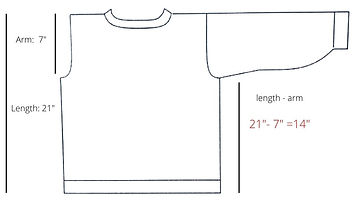We, ladies, tend to see ourselves bigger than we actually are. Because of that, we don't use the right size when it comes to crochet/knit/sewing patterns.
There are patterns that supposed to be bigger, loose, but there are patterns that they look better if they more fitted. So it is very important to use the right size when we're making our own wardrobe. Now, I know that many of us feel insecure about our bodies, but trust me! You're beautiful! You don't have to hide anything! Sometimes loose outfit make us even more bigger than we are.

What size should I choose for myself?
Patterns should state the bust measurements of the garment, that's the most important measurement. The other is the measurements of wrist/sleeves.
(Sometimes it is important to know our hip measurement as well.)
So the first step is to measure ourselves.
Then we have to compare our measurements to the measurements of the pattern. NOT to the sizes the designer gives us! According to some designers I'm a size M, for other designers I'm a size S. I learnt it the hard way, that those numbers don't say much, I need to look at the design and its measurements. BUT!!!! Even though I measured myself and I compared those numbers to the design, I always check the fit as I knit/corchet to make sure the fit will be perfect for my body/size. Especially if I use different material than the designer used.
What about the length of the design?
I usually give a suggested length for my designs but those are just suggestions. Designers don't really know the length of your torso, your legs, and your arms. And of course when it comes to preferences of the length, we are definitely different. I don't mind short(er) sweaters, but many people prefer longer ones. When we have a design that the back/front panel is a simple rectangle, there should not be any problem with the fit after we determined the length we want to achieve.
But what if the sweater/top/cardigan has armholes.
How do I know when should I start decreasing for the armholes? If the pattern has arm shaping,

the pattern usually states the measurement of those. So it's pretty easy to calculate. I measure the length I want the sweater/top to be from my shoulders to my hips or thighs. Then I look at the arm hole measurements of the design and I calculate when I need to decrease for the sleeves. For example. If I want the length of my sweater to be 21' and the arm holes are 7", I need to knit/crochet 14" and then decrease for the armholes.
If you have a lace design, it is very important to know the stretch of your material, meaning how your yarn reacts to blocking. The best way to avoid disappointment is to make a swatch with the lace pattern and block the swatch. Measure the swatch before blocking and after blocking and compare the 2. The other thing you can do with lace design. is to stretch your unblocked piece and measure that way.

Here's an example how blocking can make our pieces bigger, wider.
Your tension is also different then the designer's tension, so to avoid disappointments, definitely make swatches. I know that it may sound like a waste of yarn, but in the long run, it will pay off.
Here you can read about blocking : https://www.erikadesigncanada.com/post/blocking-your-handmade-projects
And the sleeves?
Usually the sleeves have positive ease but to be completely safe, MEASURE the circumference of your arms. My arms/biceps are bigger than the average, so I always have to check the design for the arm openings, and I crochet/knit one size bigger sleeves when it's necessary.
It's also important to know the length of your arms. The length of my arms are pretty average, but that's not the case for everybody.
How I make sure my sleeves has the perfect length? First: measure (I know, I know... :-) ) When I think that the length is enough, I use safety pins or my stitch markers and pin the sleeve(s) to the (pined together or sewn together) shoulders. Then I put the top/sweater/etc on to see if I need to keep going crocheting/knitting the sleeves or I can finish them off. That's it! Of course the problems of the lace patterns can be the same as above for the back/front panels.
If you're making a top down sweater/top/etc on circular needles/in the round. all you have to do is to try your piece on as you go.
Hope this short blog post helps with your fit!
Don't forget my FB group (Erika Design - Knitting tutorials and more), so I can help you with knitting/crochet questions you might have.
Pls tag me on Social Media when you make something after checking my tutorials/blog/patterns: https://linktr.ee/ErikaDesign

Thank you for reading,

Comments
Post a Comment